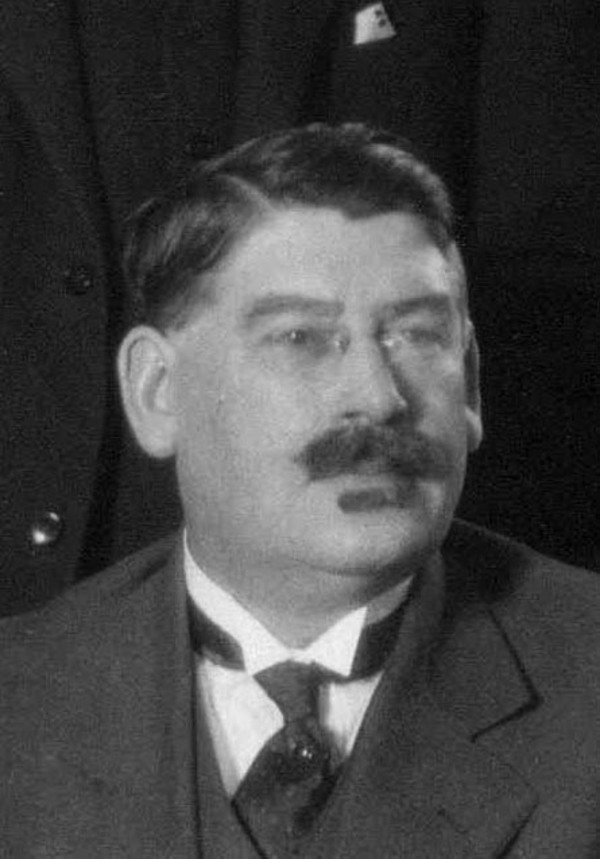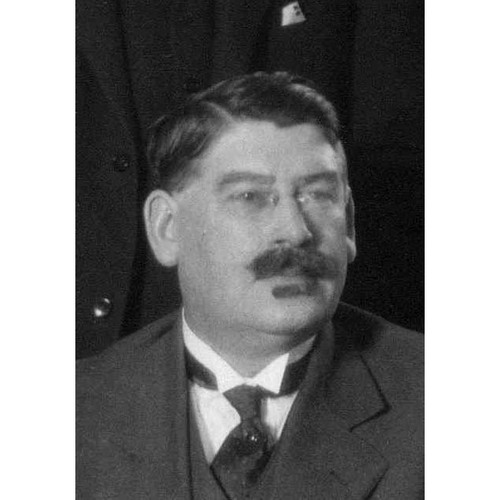
Source: Link
LEFEBVRE DE BELLEFEUILLE, GASTON (baptized Joseph-Gaston) (he sometimes spelled the first part of his family name Lefébure), psychiatrist, professor, and author; b. 12 Jan. 1882 in Montreal, son of Édouard Lefebvre de Bellefeuille and Agnès Anna Macdonell; m. 15 May 1907 Marie-Cécile Dolbec in Saint-Eustache, Que., and they had two sons; d. 21 Sept. 1938 in Montreal and was buried two days later in the Saint-Eustache cemetery.
Gaston Lefebvre de Bellefeuille came from a family of prominent individuals and seigneurs [see François Lefebvre* de Bellefeuille; Jean-François Lefebvre* de Bellefeuille]. His father, a lawyer, had also been a journalist and Papal Zouave. After completing his classical studies at the Collège Sainte-Marie in Montreal, in 1901 Gaston enrolled in the faculty of medicine at the Université Laval in that city. His interest in medicine no doubt came from his grandfather, Dr Angus Cameron Macdonell. In 1905, having excelled in all subjects, he obtained his md with the highest honours.
That year Lefebvre de Bellefeuille was already an intern at the psychiatric institution Hôpital Saint-Jean-de-Dieu in Montreal. The superintendent, Dr Georges Villeneuve, strongly encouraged him to go to Paris to specialize in psychiatry. On his return to Canada in 1909 he was appointed physician in charge of the women’s section at Saint-Jean-de-Dieu and assistant to Alcée Tétreault, chief of the medical staff at the establishment. He would hold these positions until 1926.
From 1911 Lefebvre de Bellefeuille was an associate professor in the faculty of medicine at the Université Laval in Montreal and aided Villeneuve in giving clinical instruction on mental illnesses at the Hôpital Saint-Jean-de-Dieu. He rose in status from clinical assistant to acting physician in 1919 and from associate to tenured professor in 1928. He also taught mental health at the École d’Hygiène Sociale Appliquée, which since its opening in 1925 had been affiliated with the faculty of medicine at the Université de Montréal. At the time of his death in 1938, he was a member of the governing council of the faculty of medicine at the Université de Montréal.
In 1929 the Committee for Mental Hygiene of the Province of Quebec created a mental-health unit within the children’s hygiene branch of Montreal’s department of health services. Lefebvre de Bellefeuille and his colleague Omer Noël, as well as two nurses who had been trained in psychology, were hired to conduct a psychometric examination of certain pupils in the first three primary grades of the Roman Catholic and Protestant schools of Montreal. The objective of this procedure was to identify the pupils who, by reason of their intellectual shortcomings or emotional problems, would have to be excluded from regular classes and placed in special classes. Thus, beginning in 1931 the Montreal Catholic School Commission set up about 60 such classes. As for pupils coping with more severe disabilities, they were sent to the Gamelin and La Jemmerais schools, located on the grounds of the Hôpital Saint-Jean-de-Dieu and Quebec City’s Hôpital Saint-Michel-Archange respectively. In an article published in 1934 in L’Union médicale du Canada, Lefebvre de Bellefeuille reported that of the 11,561 pupils examined in 184 Montreal schools between 1929 and 1933, 4,427 children were pronounced “retarded,” 1,636 were termed “retarded and unstable,” and 349 were classified as “unstable.”
After observing that the use of the French-language version of the Stanford-Binet tests for measuring intelligence (the American adaptation of the Binet-Simon tests developed in France) reduced the tests’ level of difficulty, Lefebvre de Bellefeuille undertook a review and a comparison with versions produced in other countries, including Switzerland and Belgium. The result, Manuel de technique psychométrique, published in Montreal in 1933 at the expense of the Committee for Mental Hygiene, would ensure his renown. Large parts of this publication appeared in L’Union médicale the same year. According to Canon Gustave Jeanjean (director of the laboratory of applied psychology at the Institut Catholique de Paris and an expert in the field of psychometric tests), who wrote the preface to the manual, Lefebvre de Bellefeuille’s work was “much superior to the Geneva version.”
In 1931–32 Lefebvre de Bellefeuille took part in a series of lectures on mental health that were broadcast on the radio and published in book form. In his opinion psychiatry should not confine itself to treating disorders of the mind, but, in line with what he had written in an article in L’Union médicale in 1930, it must also “deliver preventive mental medicine, mental health, a science that concerns not only those with damaged psyches, but every human being.”
In his capacity as a psychiatrist, Lefebvre de Bellefeuille was called on to testify as an expert at a number of criminal trials, the most famous of which was undoubtedly that of Abbé Adélard Delorme, who was charged with the murder of his brother in 1922. An expert witness for the defence, Lefebvre de Bellefeuille emphasized during the first of four trials that the accused’s intellectual faculties were unevenly developed. Moreover, there were several reported cases of mental illness and intellectual disability in the abbé’s family. The jury subsequently declared that the accused was not fit to stand trial, and he was confined to the Hôpital Saint-Michel-Archange.
In the course of his career, Lefebvre de Bellefeuille was a member of the Association des Médecins de Langue Française de l’Amérique du Nord [see Michel-Delphis Brochu], the Société Médicale de Montréal, of which he was president in 1929–30, the Société Médico-Psychologique de Paris, and the American Psychiatric Association. His colleagues viewed him as a cultured gentleman who was very respectful of tradition.
Prior to his sudden death in 1938, Gaston Lefebvre de Bellefeuille had lost his son Henri on 5 Oct. 1915, his wife Marie-Cécile on 6 Feb. 1934, and his son Hertel on 7 Nov. 1937. Since 1935 Hertel had been working as a psychiatrist under the direction of his father at the Hôpital Saint-Jean-de-Dieu. Through his writings and actions, as well as through the dissemination and improvement of psychometric tests among the school population, Gaston Lefebvre de Bellefeuille made a great contribution to developing measures to prevent mental illness in Quebec during the period between the two wars.
Gaston Lefebvre de Bellefeuille is the author of several articles, including these published in L’Union médicale du Canada (Montréal): “Corps étranger de la vessie chez une aliénée,” 49 (1920): 84–88; “L’automutilation chez l’aliéné,” 53 (1924): 311–18; “L’abcès de fixation dans la pratique psychiatrique,” 54 (1925): 231–42; “À propos d’un cas d’hallucinations liliputiennes,” 58 (1929): 87–98; “Le suicide et la responsabilité,” 58 (1929): 664–70, 729–39; “Évolution de la maladie mentale,” 59 (1930): 159–62; “Manuel de technique psychométrique,” 62 (1933): 355–64, 460–69, 578–601, 697–735, 816–56, 930–45; “L’hygiène mentale au service de la population écolière de la ville de Montréal,” 63 (1934): 752–59; and, in collaboration with Omer Noël, “L’Hôpital St-Jean-de-Dieu,” 61 (1932): 243–55. He is also the author of “Quelques préjugés sur la folie,” in Septième congrès de l’Association des médecins de langue française de l’Amérique du Nord … texte des mémoires (Montréal, 1923), 385–94, and of “L’hygiène mentale pathologique,” Conférences sur l’hygiène mentale données à la radio ([Montréal, 1932?]), 67–73.
BANQ-CAM, CE601-S51, 13 janv. 1882; CE606-S11, 15 mai 1907, 7 oct. 1915, 9 févr. 1934, 10 nov. 1937, 23 sept. 1938. Le Devoir, 22 sept. 1938. La Patrie, 23 sept. 1938. La Presse, 26, 27, 28 juin 1922; 21 sept. 1938. Robert Bastien et Isabelle Perreault, “Propagande d’hygiène mentale au Québec dans les années 1930,” Lien social et politiques (Montréal), no.67 (2012): 85–105. BCF, 1924. E.‑P. Benoit, “In memoriam: Gaston Lefébure de Bellefeuille, 1882–1938,” L’Union médicale du Canada, 67 (1938): 1139–40. Martin Pâquet et Jérôme Boivin, “La mesure fait loi: la doctrine de l’hygiène mentale et les tests psychométriques au Québec pendant l’entre-deux-guerres,” CHR, 88 (2007): 149–79. Isabelle Perreault, “Psychiatrie et ordre social: analyse des causes d’internement et des diagnostics donnés à l’hôpital Saint-Jean-de-Dieu dans une perspective de genre, 1920–1950” (thèse de phd, univ. d’Ottawa, 2009). Service de Santé de la Cité de Montréal, Rapport, 1929–39. Univ. de Montréal, Directory, 1923–39. Univ. Laval à Montréal, Annuaire, 1902–22.
Cite This Article
Guy Grenier, “LEFEBVRE DE BELLEFEUILLE, GASTON (baptized Joseph-Gaston) (Lefébure),” in Dictionary of Canadian Biography, vol. 16, University of Toronto/Université Laval, 2003–, accessed January 1, 2026, https://www.biographi.ca/en/bio/lefebvre_de_bellefeuille_gaston_16E.html.
The citation above shows the format for footnotes and endnotes according to the Chicago manual of style (16th edition). Information to be used in other citation formats:
| Permalink: | https://www.biographi.ca/en/bio/lefebvre_de_bellefeuille_gaston_16E.html |
| Author of Article: | Guy Grenier |
| Title of Article: | LEFEBVRE DE BELLEFEUILLE, GASTON (baptized Joseph-Gaston) (Lefébure) |
| Publication Name: | Dictionary of Canadian Biography, vol. 16 |
| Publisher: | University of Toronto/Université Laval |
| Year of publication: | 2020 |
| Year of revision: | 2020 |
| Access Date: | January 1, 2026 |



